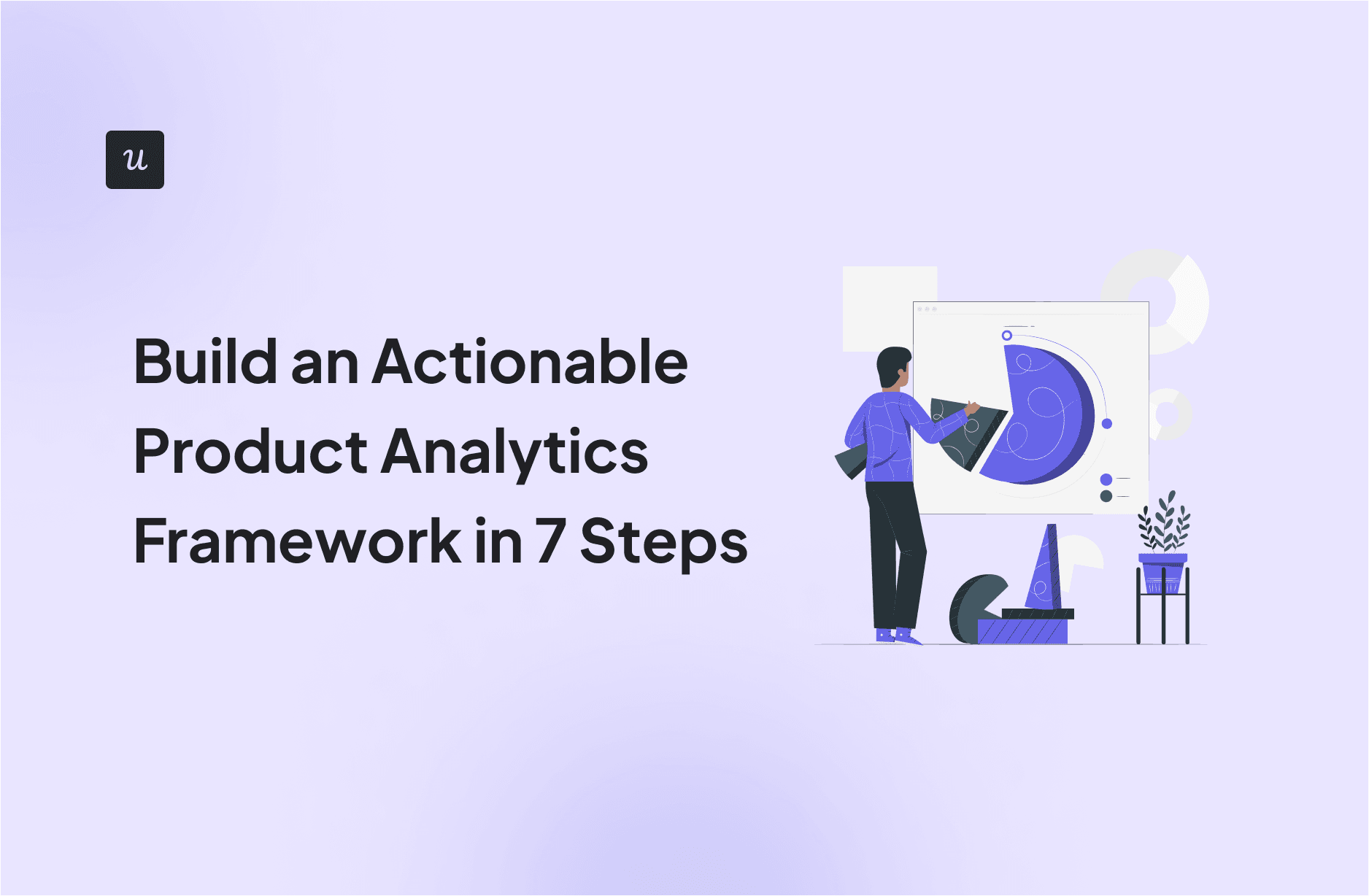
Modern businesses don’t have a data-collection problem. With the abundance of analytics tools available, collecting information about user behavior and preferences is easier than ever. The real challenge?
Transforming this raw data into valuable insights that drive business growth. This is where a product analytics framework becomes essential.
But what exactly is a product analytics framework, and how can it help you achieve your business goals? We’ll explore the core components of a successful framework and guide you through seven essential steps to design your own.
Try Userpilot Now
See Why 1,000+ Teams Choose Userpilot

What is a product analytics framework?
First, let’s quickly recap the basics of product analytics itself. Essentially, it’s all about gathering and analyzing data on how users interact with your product. The goal? To understand the nuances of user behavior and deliver better product experiences.
A product analytics framework, therefore, provides a structured approach to this process. Think of it as a roadmap that guides you through leveraging user data to make informed product decisions.
Are product analytics frameworks actually useful?
Short answer: Yes.
While it might seem like “just another system,” a well-implemented product analytics framework provides significant benefits that go beyond simply collecting data.
Here’s how:
- Gain clarity and focus: A solid framework helps you avoid chasing vanity metrics and focus resources on the KPIs that truly matter to your business.
- Get actionable insights: Struggling to understand the whys behind user activity? A robust analytics framework will provide valuable data you can start acting on immediately.
- Make more data-driven decisions: Establishing clear processes for collecting, analyzing, and interpreting data helps your team base decisions on concrete evidence rather than gut feelings.
- Improved product development: From tracking the impact of existing features to identifying value gaps, a product analytics framework empowers you to build solutions that satisfy your customers’ core needs.
- Increased efficiency: The fact that everyone can access and interpret the same data will boost cross-functional output and reduce time wasted on conflicting interpretations.
What kinds of analyses are included in a product analytics framework?
This section explores the essential analyses that form the backbone of a robust product analytics framework. We’ve categorized it into four buckets for easy interpretation:
- Understanding user behavior.
- Analyzing user journeys.
- Identifying trends and optimizing for conversions.
- Understanding user success and churn.
1. Understanding user behavior
This analysis gives you granular insights into how users interact with your product. You can gather user behavior data through…
Segment and cohort analysis
Segment users by demographics, in-app behaviors, jobs-to-be-done (JTBD), or any other relevant factor.
Then group them into cohorts for comparative analysis. This way, you can easily spot patterns and tailor your strategies to each group. For example, you might find that users who complete a specific onboarding task within the first 24 hours are significantly more likely to convert to paid plans. This could lead you to prioritize and optimize that onboarding task to drive faster activation.
Not sure how to segment users and perform cohort analysis? Userpilot provides all the tools you need to do it code-free. Here’s an example of a retention cohort analysis performed with Userpilot.
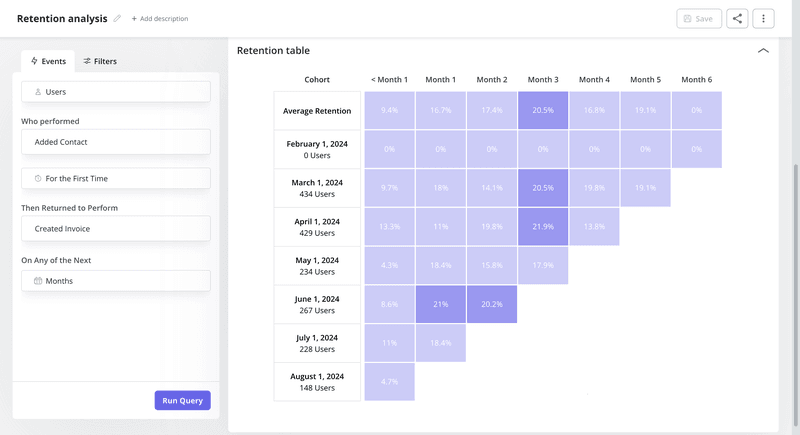
2. Analyzing user journeys
Understanding standalone behaviors might not be enough to give you the full picture. This is where journey analysis shines—it helps you map out the paths users take within your product, from initial engagement to conversion and beyond.
Customer journey and funnel analysis
For even better results, it’s a good practice to combine customer journey analysis with funnel tracking.
Think of it this way: user journey mapping provides a high-level view of the overall user experience, while funnel analysis zooms in on specific stages or processes to identify bottlenecks and areas for improvement.
Userpilot can provide clear visualizations to make your analysis faster:
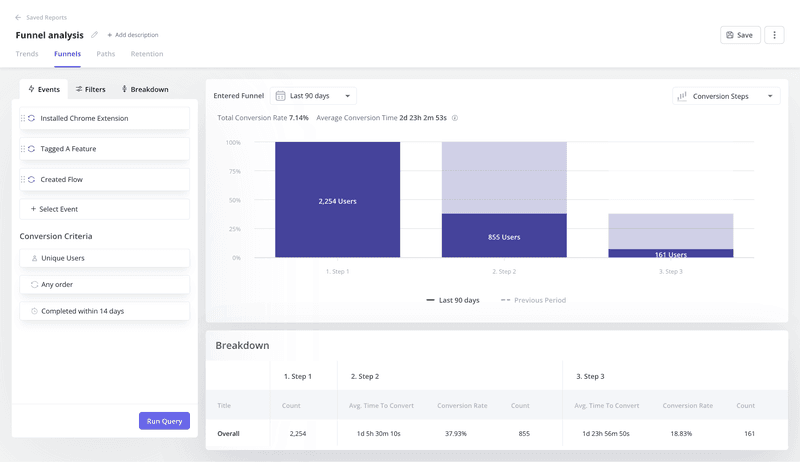
3. Identifying trends and optimizing for conversions
This involves analyzing data over time to connect the dots in user behavior.
Trend and conversion analysis
Combine trends and conversion analysis to identify patterns and optimize for future conversions. For instance, you might discover that users who consistently utilize your API access feature are significantly more likely to upgrade to the premium plan. Based on this knowledge, you can proactively target cohorts exhibiting this “power user” behavior with tailored messaging and offers that encourage them to upgrade.
Userpilot’s product analytics dashboards and reporting features allow you to track your most important metrics and visualize their changes over time. Here’s an example of using this dashboard to track product usage metrics:
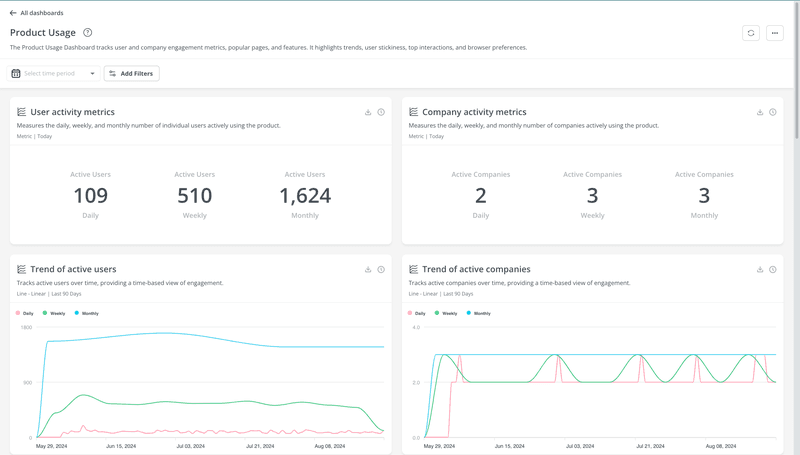
We also have a standalone trend analysis feature that you can use to track specific user events:
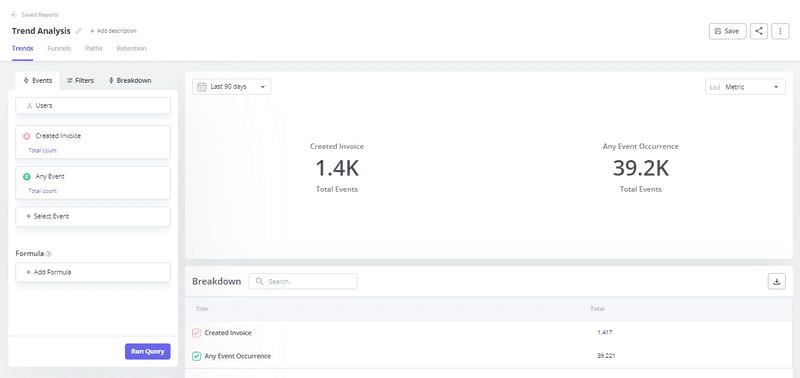
4. Understanding user success and churn
This fourth category is where you analyze factors that contribute to user success, long-term engagement, and, ultimately, retention.
Attribution, churn, and user retention analysis
Pair user flow data with direct customer feedback to properly identify the factors responsible for churn and customer retention.
For example, imagine your user flow analysis reveals a significant drop-off point during the onboarding process where users are asked to integrate with a third-party tool.
To understand why users abandon the process at this stage, you could trigger an in-app survey that asks questions like:
- “Did you find this step easy to understand?”
- “Are you encountering any difficulties with the integration?”
- “Is there anything we can do to improve this process?”
Analyze the results to understand users better and increase your engagement rates.
You can use our platform to gather data and analyze in-app surveys code-free. Here’s what the survey analytics looks like:
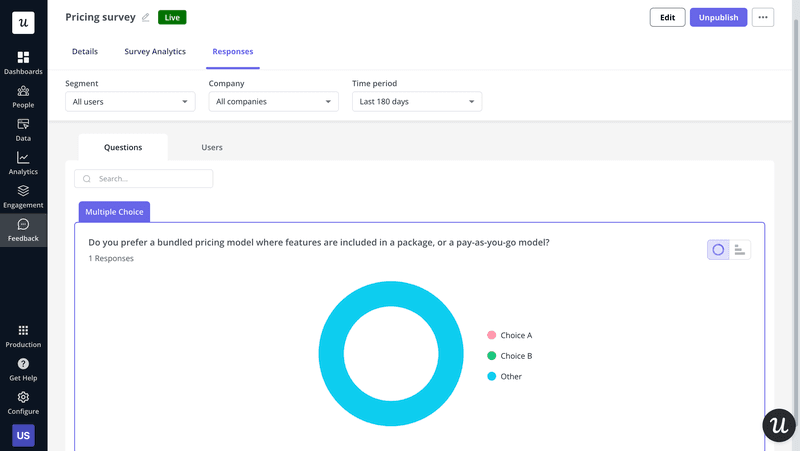
7 steps for designing a successful product analytics framework
Now that we know the “why” and the “what,” let’s dive into the how of building your own framework.
Step 1: Assemble your data dream team
The first step is to get your key stakeholders on board. Instead of limiting yourself to your product team, aim to create a cross-functional data team with experts from various departments. This allows ideas to flow easily and ensures you have a holistic view of the customer experience.
Who should be on this team? While it varies depending on your organization’s structure, some essential roles include product managers, data analysts, engineers, marketers, customer success representatives, and even designers. You can add more if your business goals demand it.
No matter how large or small your team is, try to keep everyone updated by establishing clear communication channels through regular meetings, shared analytics dashboards, or collaborative workspaces. This will make it easier to track progress and guarantee everyone is working towards the same vision.
Step 2: Define crystal-clear objectives
After setting up your dream data team (or at least having an idea of the members to onboard), the next step will be to define the overarching goals of your product analytics efforts.
To do this, take a moment to ask yourself: what are we trying to achieve? What goals matter most to us this year or for the next couple of months?
Here are some examples to help you get thinking:
- Increase user engagement: Perhaps you want users to interact with your product more frequently, explore more features, or simply spend more time within the app.
- Improve user retention: Are you losing users too quickly? Focus on reducing churn rate, increasing customer lifetime value, and identifying factors that contribute to long-term user loyalty.
- Enhance user onboarding: Is your onboarding process effective in getting users up to speed and activated? Define objectives around improving onboarding completion rates, reducing time-to-value, and increasing early feature adoption.
Choose product analytics goals that connect with your broader business objectives. For instance, if your company aims to increase revenue by 20% this year, your product analytics objectives might focus on driving product-led growth, increasing conversion rates to paid plans, or improving customer lifetime value.
Use the SMART goal-setting framework to keep your goals focused and actionable:
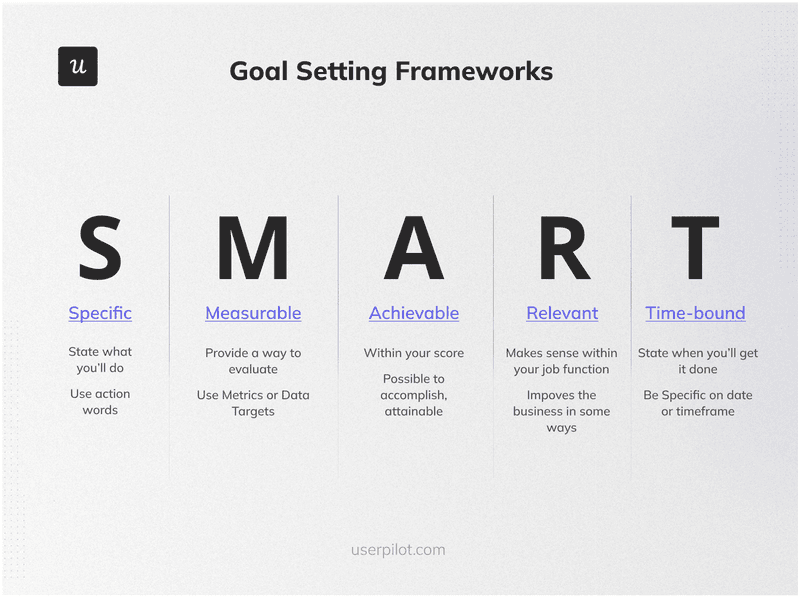
Step 3: Choose your metrics wisely
Once you have well-defined objectives, the next step is to identify the key metrics that will measure your progress toward those goals.
Consider a mix of leading and lagging indicators:
- Leading indicators, such as active users or feature usage, provide data-driven insights into future performance and allow for proactive intervention.
- Lagging indicators, like churn rate or customer lifetime value, reflect past performance and help evaluate overall success.
Avoid vanity metrics that don’t provide actionable insights. Examples include the sheer number of features built, the number of users, and website traffic. While these are important, they don’t directly translate to product success or user satisfaction.
New to product analytics tools and metrics? Userpilot’s product design lead Kevin O’Sullivan shares some practical tips to help you get the most out of them:
Step 4: Select your product analytics platform
Choosing the right product analytics software is crucial for efficient data collection and analysis. With a variety of options available, it’s essential to carefully evaluate your needs and select a platform that aligns with your specific requirements.
Here are some key factors to consider:
- Features
- Integrations
- Ease of use
- Scalability
- Pricing
- Support
Some popular product analytics tools include Mixpanel, Amplitude, Heap, and Google Analytics. Each platform offers a unique set of features and capabilities.
For instance, Mixpanel is known for its user-friendly interface and robust segmentation capabilities, while Amplitude excels in advanced analytics and user journey mapping. Heap provides automatic event tracking, capturing all user interactions without manual tagging.
But the problem with these tools? They don’t provide a way to act on the insights without investing in a third-party user engagement platform. Recognizing this need, we built Userpilot as an all-in-one solution that combines product analytics with in-app engagement features. This allows you to not only gather customer data but also take action on those insights directly within your product.
What’s more, you can easily integrate Userpilot with other tools in your tech stack and optimize your workflows:
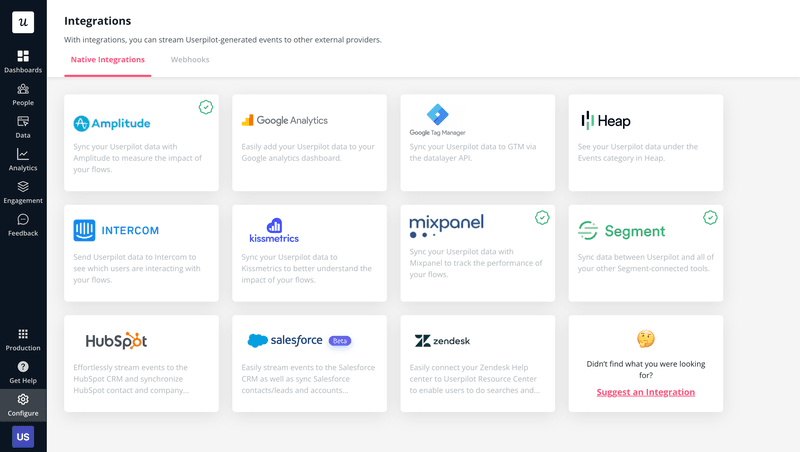
Userpilot might be the perfect fit for you if you’re looking to:
- Track and analyze user behavior with detailed event tracking and segmentation.
- Gather valuable insights into feature usage, adoption, and user flows.
- Identify friction points and areas for improvement in the user journey.
- Create customized reports and dashboards to visualize your key metrics.
- Trigger targeted messages and walkthroughs based on user behavior.
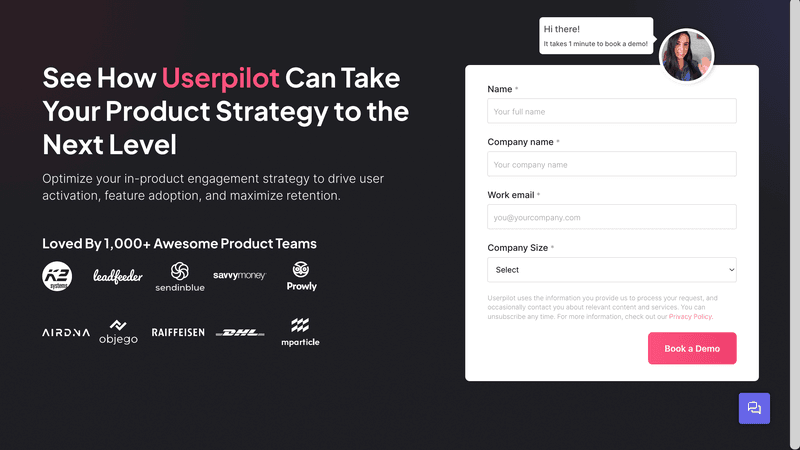
Step 5: Begin your data collection process (responsibly)
With your platform in place, it’s time to start collecting customer data. Consider the following data collection methods:
- User surveys: Gather feedback and insights directly from users through targeted surveys.
- Customer support interactions: Analyze support tickets, live chat logs, and customer feedback to understand user challenges and pain points.
- In-app feedback: Provide opportunities for users to submit feedback directly within your product through feedback forms or widgets.
- Event tracking: There are two ways to do this—work with your engineering team to implement tracking code within your product or save time and resources by using tools like Userpilot’s auto-capture to automatically track in-app events code-free:
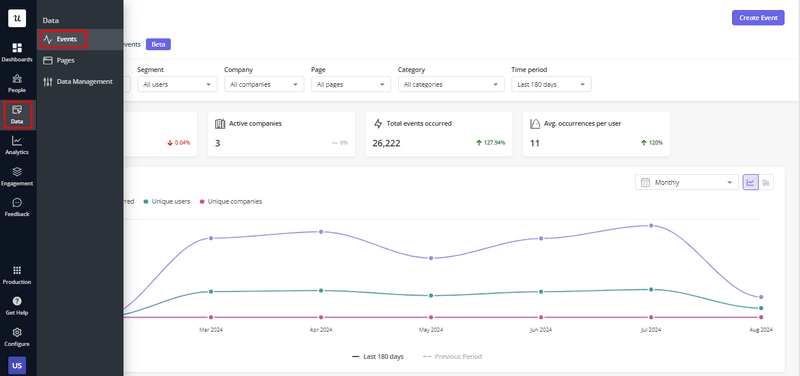
Step 6: Analyze and interpret the data
Data collection is just the first step. The real value lies in analyzing and interpreting the data to extract meaningful insights.
Your chosen analytics platform plays a crucial role in this step. Utilize its features and capabilities to perform various analyses. Then, visualize your most important data points using charts, graphs, and dashboards to make it easier to understand and communicate insights.
Also, consider enriching your analysis with qualitative insights. For example, you can use session recordings to observe actual user sessions and understand how users interact with your product in real time.
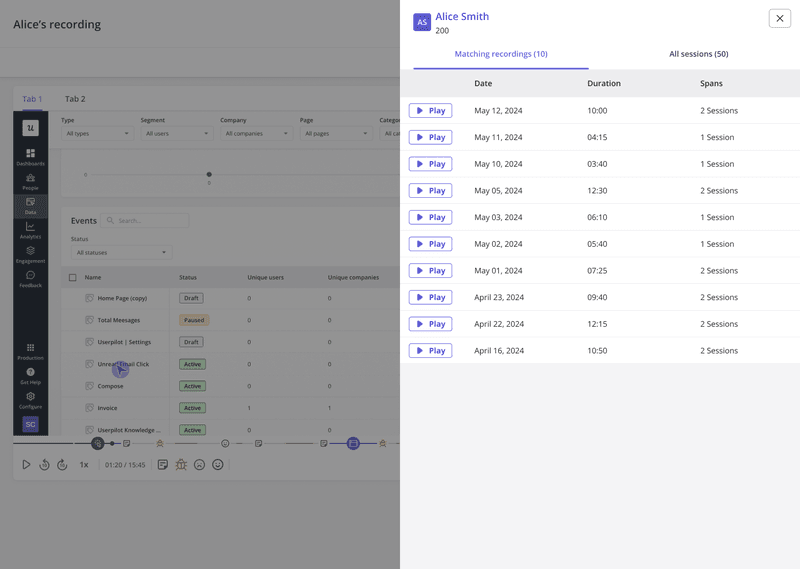
Lastly, use a custom dashboard to track your most important metrics:
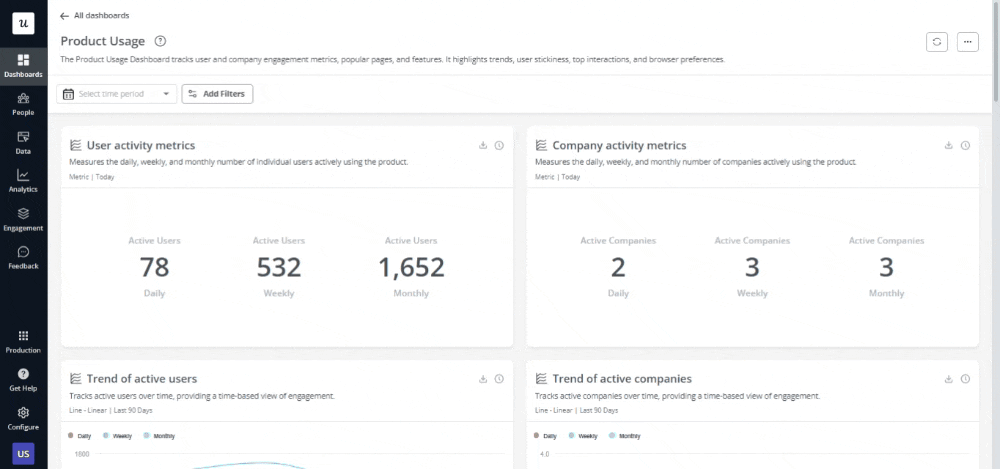
Step 7: Take action and iterate
The final step in your product analytics framework is to translate data insights into concrete actions that help you achieve your goals.
How? Begin by identifying the most impactful areas for improvement based on the data you’ve obtained so far—this can be anything from developing targeted marketing campaigns to improving existing features.
When implementing changes, leverage A/B testing to compare different versions and measure their impact on key metrics. For example, test different onboarding flows, feature variations, or messaging to see which performs best in achieving your objectives.
Again, you can do this with Userpilot. Our platform lets you conduct A/B tests, analyze the results in real time, and implement the winning version.
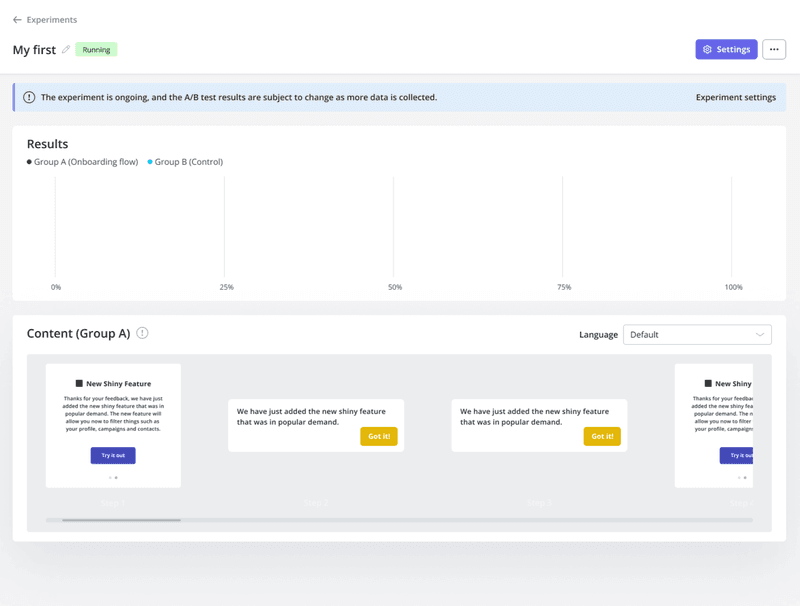
Conclusion
Remember, product analytics is not just about collecting data. What really counts is using that data to understand your users, improve their experience, and achieve your core business objectives.
Ready to take your analytics to the next level? Whether you’re creating a new product analytics framework or optimizing an existing one, Userpilot can help you collect actionable data and translate it into meaningful product improvements. Book a demo to discuss with our team!






